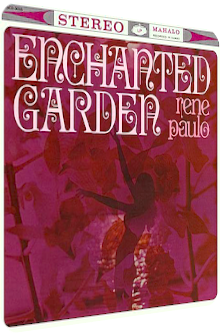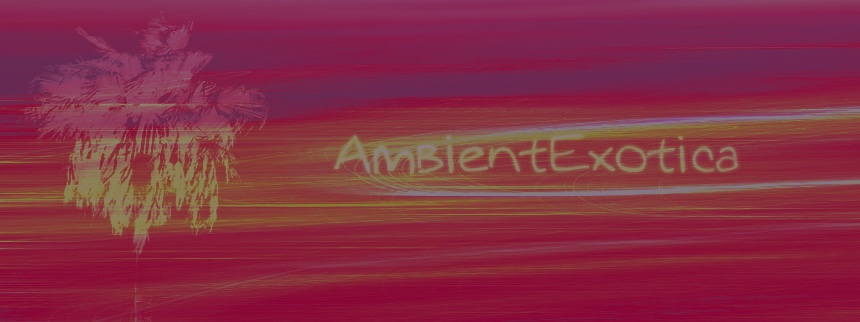
Rene Paulo
Enchanted Garden
1964
Enchanted Garden by Rene Paulo and his trio is the changing combo’s consequential follow-up to Favorite Melodies Of Japan (1963), both in the stylistic and aesthetic sense. Presenting 12 fresh and mystic garden-centric compositions of mostly Japanese and Hawaiian origin, the trio of pianist Rene Paulo (born 1930), bassist and guitarist Ed Shonk as well as drummer Bruce Hamada returns to several sunlight and twilight states. Released in 1964 on Mahalo Records, it is one of the pianist’s less obscure works, if only for the fact that it is readily available as a remastered download version, so the marketing buffs must see some value in it.
As is the case with the majority of Paulo’s albums, they cater to a certain clientele that is both fond of Exotica classics and the precise, minimal realization of these very tunes. That this is the work of a trio is indeed questionable more than a few times, as Rene Paulo’s albums are known for the inclusion of many sophisticated and exclusive piano arrangements. This translates into the fact that the other musicians are missing most of the time, and there is anything else to absorb but the piano in the spotlight, an alienating thought in the given prospect of the various scintillating colors the Exotica style otherwise exudes. However, Paulo is a master on the piano and more than able to send out a multitude of different emotions, chromatics, temperatures.
The perfect synergy of Hawaiian double-bass estuaries leading to Japanese claves and pentatonic piano florets: Masao Yoneyama’s Ringo Oiwake is a wondrously amniotic opener, surprisingly lacunar and with a moxie of its own, yet keen on emitting the clandestine majesty that superimposes panchromatic exoticism with umbrageous interstices. Already considered a year prior as part of the pianist’s Favorite Melodies Of Japan, the shorter version fittingly enchants in this here album as well. Hoagy Carmichael’s horticultural Blue Orchids follow suit as the piano arrangement is only carefully amended by Ed Shonk’s double bass, but remains a matutinally dewy affair, spawning particularly liquid tone sequences and plasmatic polyphonies which transfigure the florets further. Not necessarily exotic per se, there is a mesozoic gravitas in the air, a certain weight that comes along with this kind of worship.
With the advent of the traditional Hana Kotaba No Uta aka Song Of Flower Words, Rene Paulo’s Enchanted Garden reaches a diaphanous suntrap of gracefully pulsatile piano rotations and aqueous glissando patterns spawned by anything but the pianist’s signature instrument in the limelight, whereas Charles E. King’s following Lei Aloha Lei Makamae is cautiously augmented by ligneous double bass rhizomes protruding the ultramafic alluvial soil of this aural garden. The Hawaiian spirit is not completely amiss, as one can feel the aura of a ukulele shimmering through certain high notes, although this is but a mere mirage, a fugacity that photodissociates soon enough. Bonus points are awarded for a short appearance of Bruce Hamada at the very end of the arrangement, gently tipping a Chinese gong, thus offering a cryovolcanic endpoint to a lush coppice. While Lilacs In The Rain by Mitchell Parish and Peter DeRose is a multilayered orthorhombic mica with luringly retrosternal piano droplets, guitar chords and a double bass bokeh, King’s Serenade by, well, Charles E. King ends side A with a glockenspiel-accentuated pianocentric lullaby of aureate tercets.
Side B keeps on delivering the nomological perianths, be they in the shape of King’s third inclusion Pua Carnation which Exotica lovers love for its genteel punctilio and its agglutinated benthic physiognomy, Keola Beamer’s like-minded but orange-colored sunset sparkler Pua Tubarose, presented here stripped to the bones in the shape of a dedicated piano arrangement, or King’s final consideration Beautiful Kahana that tones down the crimson hue in favor of a glaucous-viridian viscoelasticity, once more emanated by anything else but Rene Paulo’s signature instrument. The traditional Sweet Lei Lehua is closely attached to the adjacent Beautiful Kahana, but actually much more gelid without letting its plinking complexion translate into cold hoarfrost; the high tones are rather used for the sake of pristine purity.
The final two songs are quite surprising considering the overall garden-centric viewpoint, but they are moony and bring in a soft glow of moony big band avulsions: Bart Howard’s Fly Me To The Moon is a laid-back, enthrallingly glistening piano serenade that shakes off its pompously brazen moxie in this heartfelt rendition, whereas Rentarō Taki’s Moon On The Ruined Castle – already a stellar highlight on Arthur Lyman’s Bwana Ā (1958) – sees the trio come full circle with a strikingly Japanese peritoneum of mysticism involving Bruce Hamada’s rufescent drums and tawny hi-hats, Rene Paulo’s piano in hatched colors aswell as Ed Shonk’s pale guitar chords. A nocturnal endpoint breaking the spell in the most tasteful way.
The existence of Enchanted Garden is a marvel to begin with, and so is its remastered state and availability as a digital download. Rene Paulo manages once again to deliver sparkling, languorous and enigmatic piano arrangements at the risk of losing more than a few Exotica fans on his way. The reason is obvious and all the more painful: the other musicians are not only severely outshone by Paulo’s craftsmanship but completely amiss in about 75% of the album’s runtime! This fact may be hard to swallow, and I have to admit that I previously considered myself part of that very group, especially so when two things are taken into account: firstly, the genre can be so vivacious and the pool of instruments so tremendously wide and weird that it is quite a loss that the most exotic instrument on Enchanted Garden is a pair of Japanese tonewoods, aka claves.
Secondly, Rene Paulo and his trio showcase the possibilities and opportunities of the presented material, for there are ten piano-focused songs encapsulated in two strongly Japanese gems, both of them the result of real teamwork and superimposed textures. Ringo Oiwake and Moon On The Ruined Castle are therefore the clear-cut highlights for the devoted Exotica fan. Followers of the blossoming minimalism, however, will find more than an accidental delight in the remaining roster of floralcy. The pianist’s oscillation between aureate hues, purple bursts and varying temperatures is worth anyone’s while who is willed to absorb Rene Paulo’s seemingly parochial aim.
Exotica Review 427: Rene Paulo Trio – Enchanted Garden (1964). Originally published on Apr. 18, 2015 at AmbientExotica.com.
